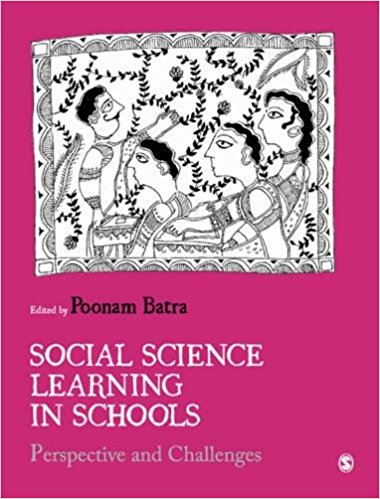Social Science Learning in Schools explores the central role of the teacher, importance of textbooks, and methods of social science enquiry in teaching-learning processes of school education in India. The collection of articles in this book presents an analysis of Eklavya’s social science texts which have been in use for 15 years in government schools in Madhya Pradesh. Each of the articles re-establish the significance of familiarizing children with a basic understanding about societies and social change, helping them develop critical skills essential for social analysis, understanding diversities of perception and assessing sources of identities to build a just and egalitarian social order (p. xi) Exploring the space around the agency of the child and the teacher in the teaching and learning of social sciences,
The book portrays a journey that links the teaching of social science with pedagogical theory by addressing ideological concerns embedded in the selection and presentation of social science materials in consonance with the developmental context of learners. It demonstrates how the social world of the learner can be projected as an object of study and a process by constantly encouraging learners to reflect.
The Eklavya experiment in education is a unique developmental model. The social science learning in schools in this perspective has been brilliantly analysed where the arguments become compulsory reading for educationists in India. The problematization of various concepts to accommodate the diverse opinions on the same analytical categories for instance is a unique effort of the Eklavya experiment. The curricular reform of this kind at the school education level, will definitely create the Gramscian ‘organic intellectual’ formations for higher education. However, the state’s opposition to Eklavya over the years nullifies these formations.
In India, the textbook, ‘constitutes the most important tool and yet the most criticized and controversial aspect of our education system’ (p. 29). The textbooks over the years have been produced mainly from the perspective of the structure where students’ agential notions often get overlooked. Eklavya however reversed this process. In this context, the central purpose of this book is to highlight the alternative curricular perspective by the Eklavya experiment. In the curricular processes, the Eklavya experiment has attempted to inclusively accommodate all the aspects by identifying the issues. By listing the objectives of teaching any subject in the social sciences, the Eklavya experiment is successfully documenting the curricular as well as pedagogic issues. The alternative paradigm proposed out of this experiment to a large extent is valuable for any reform effort in the school education in India. For this journey of exploring alternatives for social science education, the pedagogic sensitivity towards children’s requirements has been highlighted. The constructivist paradigm forms the basis for the child-centred curriculum. The systematic review of literature by the Eklavya team in this context took up the challenging task of crafting a curriculum and teaching programme for social science guided by this new perspectives of learning.
The curriculum frameworks over the decades are being framed by the ideological contestation of the political regimes in the country. In this curricular formulation, the ideology of the ruling elite drives the perspectives. The statist worldview in this process of contestation accommodates the power relations. The present book in this context offers by its suggestions about inter-linkages a fresh perspective, instead of merely looking at the social sciences as an isolated subject domain. However, the author fails to accommodate the diverse ideological underpinnings in her National Curriculum Framework (NCF) celebrations. For instance, though the cultural nationalistic leanings of the NCF 2000 are problematic, it is surprising why Batra fails to understand the political process of ideological contestations. She on the one hand accepts that ‘education is neither neutral nor value-free’ (p. 24), but on the other hand fails to highlight political process issues irrespective of the differences in a democracy. While the secular constructivist pedagogical notion is very important, the ideological contestations are also very essential for the political process for any democratic country. Unfortunately, Batra overlooks these in her genuine arguments against the ideologies in curriculum (p. 10).
However, it must be acknowledged that the NCF 2005, builds a strong case for an epistemological shift in the manner in which social sciences are taught in Indian schools. The book shows the valuable trajectory of the Eklavya experiments. For instance, the reviewers make a special mention of how the presentation of content, treatment of concepts, the language of the texts, the choice of words and the narrative style project an image of the child as active and curious (p. 35). The Eklavya textbooks, for this very reason, mainly project people as active participants in social processes—people who understand the world around them and intervene actively in bringing about positive social change (p. 254). This is one of their biggest strengths.
These analyses offer a candid articulation of the challenges encountered in writing innovative school textbooks and in reframing an engagement with social science concepts and perspective. The book has valuable analytical merits and a few shortcomings. The bulky chapters with the repetitive arguments distract readability. For instance, the section on ‘The Emergence of Social Sciences: Brief Historical Overview’ has mainly been supported by the repetitive sources of literature. The monotonous referencing (of Wagner 1999 and Wallerstein 1997, 1999) bothers readability.

